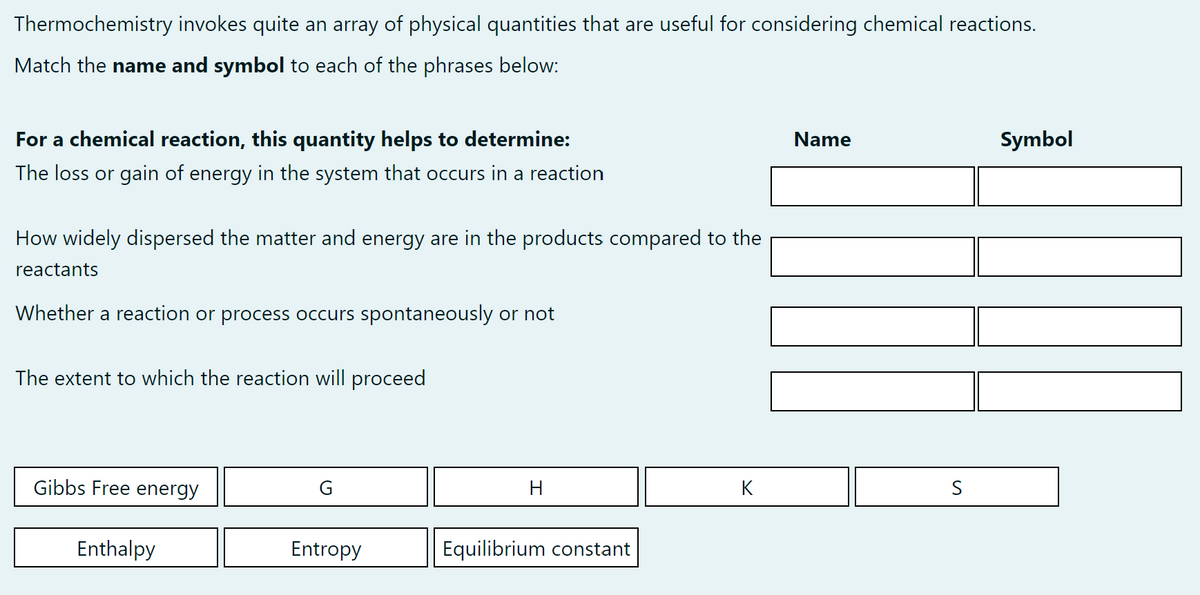Thermochemistry invokes quite an array of physical quantities that are useful for considering chemical reactions. Match the name and symbol to each of the phrases below: Name For a chemical reaction, this quantity helps to determine: Symbol The loss or gain of energy in the system that occurs in a reaction How widely dispersed the matter and energy are in the products compared to the reactants Whether a reaction or process occurs spontaneously or not The extent to which the reaction will proceed Gibbs Free energy G H K Enthalny Entropy Equilibrium constant S
Thermochemistry invokes quite an array of physical quantities that are useful for considering chemical reactions. Match the name and symbol to each of the phrases below: Name For a chemical reaction, this quantity helps to determine: Symbol The loss or gain of energy in the system that occurs in a reaction How widely dispersed the matter and energy are in the products compared to the reactants Whether a reaction or process occurs spontaneously or not The extent to which the reaction will proceed Gibbs Free energy G H K Enthalny Entropy Equilibrium constant S
Chemistry by OpenStax (2015-05-04)
1st Edition
ISBN:9781938168390
Author:Klaus Theopold, Richard H Langley, Paul Flowers, William R. Robinson, Mark Blaser
Publisher:Klaus Theopold, Richard H Langley, Paul Flowers, William R. Robinson, Mark Blaser
Chapter5: Thermochemistry
Section: Chapter Questions
Problem 51E: A sample of 0.562 g of carbon is burned in oxygen in a bomb calorimeter, producing carbon dioxide....
Related questions
Question

Transcribed Image Text:Thermochemistry invokes quite an array of physical quantities that are useful for considering chemical reactions.
Match the name and symbol to each of the phrases below:
For a chemical reaction, this quantity helps to determine:
Name
Symbol
The loss or gain of energy in the system that occurs in a reaction
How widely dispersed the matter and energy are in the products compared to the
reactants
Whether a reaction or process occurs spontaneously or not
The extent to which the reaction will proceed
Gibbs Free energy
G
H
K
Enthalpy
Entropy
Equilibrium constant
S
Expert Solution
This question has been solved!
Explore an expertly crafted, step-by-step solution for a thorough understanding of key concepts.
Step by step
Solved in 3 steps

Knowledge Booster
Learn more about
Need a deep-dive on the concept behind this application? Look no further. Learn more about this topic, chemistry and related others by exploring similar questions and additional content below.Recommended textbooks for you

Chemistry by OpenStax (2015-05-04)
Chemistry
ISBN:
9781938168390
Author:
Klaus Theopold, Richard H Langley, Paul Flowers, William R. Robinson, Mark Blaser
Publisher:
OpenStax

Chemistry for Engineering Students
Chemistry
ISBN:
9781337398909
Author:
Lawrence S. Brown, Tom Holme
Publisher:
Cengage Learning

Chemistry & Chemical Reactivity
Chemistry
ISBN:
9781337399074
Author:
John C. Kotz, Paul M. Treichel, John Townsend, David Treichel
Publisher:
Cengage Learning

Chemistry by OpenStax (2015-05-04)
Chemistry
ISBN:
9781938168390
Author:
Klaus Theopold, Richard H Langley, Paul Flowers, William R. Robinson, Mark Blaser
Publisher:
OpenStax

Chemistry for Engineering Students
Chemistry
ISBN:
9781337398909
Author:
Lawrence S. Brown, Tom Holme
Publisher:
Cengage Learning

Chemistry & Chemical Reactivity
Chemistry
ISBN:
9781337399074
Author:
John C. Kotz, Paul M. Treichel, John Townsend, David Treichel
Publisher:
Cengage Learning

Chemistry & Chemical Reactivity
Chemistry
ISBN:
9781133949640
Author:
John C. Kotz, Paul M. Treichel, John Townsend, David Treichel
Publisher:
Cengage Learning

Chemistry
Chemistry
ISBN:
9781305957404
Author:
Steven S. Zumdahl, Susan A. Zumdahl, Donald J. DeCoste
Publisher:
Cengage Learning

Chemistry: An Atoms First Approach
Chemistry
ISBN:
9781305079243
Author:
Steven S. Zumdahl, Susan A. Zumdahl
Publisher:
Cengage Learning